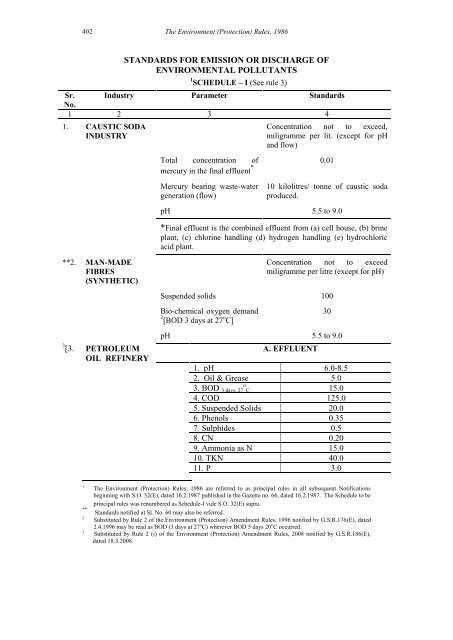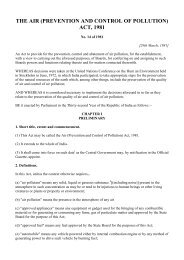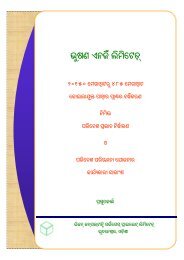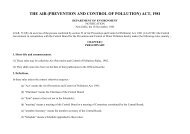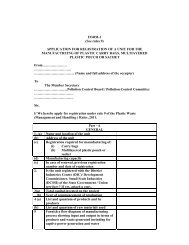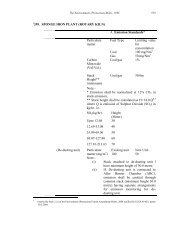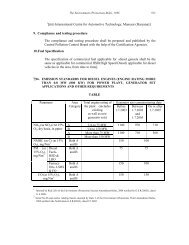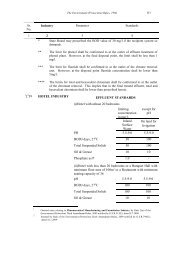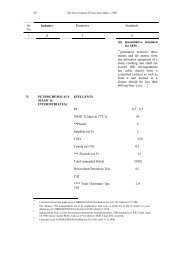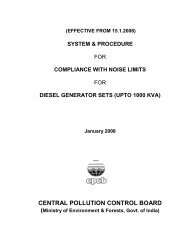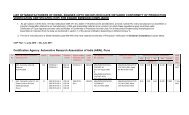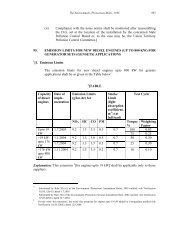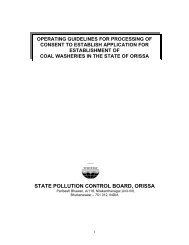Caustic Soda Industry
Caustic Soda Industry
Caustic Soda Industry
Create successful ePaper yourself
Turn your PDF publications into a flip-book with our unique Google optimized e-Paper software.
402<br />
The Environment (Protection) Rules, 1986<br />
STANDARDS FOR EMISSION OR DISCHARGE OF<br />
ENVIRONMENTAL POLLUTANTS<br />
1 SCHEDULE – I (See rule 3)<br />
Sr. <strong>Industry</strong> Parameter Standards<br />
No.<br />
1 2 3 4<br />
1. CAUSTIC SODA<br />
INDUSTRY<br />
Concentration not to exceed,<br />
miligramme per lit. (except for pH<br />
and flow)<br />
Total concentration of<br />
mercury in the final effluent * 0.01<br />
Mercury bearing waste-water<br />
generation (flow)<br />
10 kilolitres/ tonne of caustic soda<br />
produced.<br />
pH 5.5 to 9.0<br />
*Final effluent is the combined effluent from (a) cell house, (b) brine<br />
plant, (c) chlorine handling (d) hydrogen handling (e) hydrochloric<br />
acid plant.<br />
**2. MAN-MADE<br />
FIBRES<br />
(SYNTHETIC)<br />
Concentration not to exceed<br />
miligramme per litre (except for pH)<br />
Suspended solids 100<br />
Bio-chemical oxygen demand<br />
2 [BOD 3 days at 27 o C]<br />
30<br />
3 [3. PETROLEUM<br />
OIL REFINERY<br />
pH 5.5 to 9.0<br />
A. EFFLUENT<br />
1. pH 6.0-8.5<br />
2. Oil & Grease 5.0<br />
o<br />
3. BOD 3 days, 27 C 15.0<br />
4. COD 125.0<br />
5. Suspended Solids 20.0<br />
6. Phenols 0.35<br />
7. Sulphides 0.5<br />
8. CN 0.20<br />
9. Ammonia as N 15.0<br />
10. TKN 40.0<br />
11. P 3.0<br />
1<br />
The Environment (Protection) Rules, 1986 are referred to as principal rules in all subsequent Notifications<br />
beginning with S.O. 32(E), dated 16.2.1987 published in the Gazette no. 66, dated 16.2.1987. The Schedule to be<br />
principal rules was renumbered as Schedule-I vide S.O. 32(E) supra.<br />
**<br />
Standards notified at Sl. No. 60 may also be referred.<br />
2<br />
Substituted by Rule 2 of the Environment (Protection) Amendment Rules, 1996 notified by G.S.R.176(E), dated<br />
2.4.1996 may be read as BOD (3 days at 27 o C) wherever BOD 5 days 20 o C occurred.<br />
3<br />
Substituted by Rule 2 (i) of the Environment (Protection) Amendment Rules, 2008 notified by G.S.R.186(E),<br />
dated 18.3.2008.
The Environment (Protection) Rules, 1986 403<br />
Sr.<br />
No.<br />
<strong>Industry</strong> Parameter Standards<br />
1 2 3 4<br />
12. Cr (Hexavalent) 0.1<br />
13. Cr (Total) 2.0<br />
14. Pb 0.1<br />
15. Hg 0.01<br />
16. Zn 5.0<br />
17. Ni 1.0<br />
18. Cu 1.0<br />
19. V 0.2<br />
20. Benzene 0.1<br />
21. Benzo (a) – Pyrene 0.2<br />
Notes:-<br />
(i)<br />
(ii)<br />
(iii)<br />
Concentration limits shall be complied with at the outlet, discharging effluent<br />
(excluding discharge from sea water cooling systems) to receiving<br />
environment (surface water Bodies, marine systems or public sewers). In<br />
case of application of treated effluent directly for irrigation/horticulture<br />
purposes (within or outside the premises of refinery), make-up water for<br />
cooling systems, fire fighting, etc., the concentration limits shall also be<br />
complied with at the outlet before taking the effluent for such application.<br />
However, any use in the process such as use of sour water in desalter is<br />
excluded for the purpose of compliance.<br />
In case of circulating seawater cooling, the blow-down from cooling systems<br />
shall be monitored for pH and oil & grease (also hexavalent & total<br />
chromium, if chromate treatment is given to cooling water) and shall<br />
conform to the concentration limits for these parameters. In case of reuse of<br />
treated effluent as cooling water make-up, all the parameters (as applicable<br />
for treated effluent) shall be monitored and conform to the prescribed<br />
standards.<br />
In case of once through cooling with seawater, the oil & grease content in the<br />
effluent from cooling water shall not exceed 1.0 mg/l.<br />
B. EMISSIONS<br />
Limiting concentration in mg/Nm 3 , unless stated<br />
(Furnace, Boiler<br />
and Captive<br />
Power Plant)<br />
Sulphur Dioxide<br />
(SO 2 )<br />
Oxides of Nitrogen<br />
(NOx)<br />
Particulate Matter<br />
(PM)<br />
Fuel<br />
Type<br />
Existing<br />
refineries<br />
New Refinery/<br />
Furnace/<br />
Boiler<br />
Gas 50 50<br />
Liquid 1700 850<br />
Gas 350 250<br />
Liquid 450 350<br />
Gas 10 5<br />
Liquid 100 50
404<br />
The Environment (Protection) Rules, 1986<br />
Sr. <strong>Industry</strong> Parameter Standards<br />
No.<br />
1 2 3 4<br />
Carbon Monoxide Gas 150 100<br />
(CO)<br />
Liquid 200 150<br />
Nickel and Vanadium Liquid 5 5<br />
(Ni+v)<br />
Hydrogen Sulphide Liquid / 150 150<br />
(H 2 S) in fuel gas Gas<br />
Sulphur content in<br />
liquid fuel, weight%<br />
Liquid /<br />
Gas<br />
1.0 0.5<br />
Notes:-<br />
(i)<br />
(ii)<br />
In case of mixed fuel (gas and liquid) use, the limit shall be computed based on<br />
heat supplied by gas and liquid fuels.<br />
All the furnaces/boilers with heat input of 10 million kilo calories/hour or more<br />
shall have continuous systems for monitoring of SO 2 and NO 2. Manual<br />
monitoring for all the emission parameters in such furnaces or boilers shall be<br />
carried out once in two months.<br />
(iii) All the emission parameters in furnaces/boilers having heat input less than 10<br />
million kilo calories/hour will be monitored once in three months.<br />
(iv)<br />
(v)<br />
(FCC<br />
Regenerators)<br />
In case of continuous monitoring, one hourly average concentration values shall<br />
be complied with 98% of the time in a month. Any concentration value obtained<br />
through manual monitoring, if exceeds the limiting concentration value, shall be<br />
considered as non-compliance.<br />
Data on Nickel and Vanadium content in the liquid fuel (in ppm) shall be<br />
reported. Nickel and Vanadium in the liquid fuel shall be monitored at least once<br />
in six months, if liquid fuel source & quality are not changed. In case of<br />
changes, measurement is necessary after every change.<br />
Sulphur Dioxide<br />
(SO 2 )<br />
Limiting concentration in mg/Nm 3 ,<br />
unless stated<br />
Existing refineries New Refinery<br />
Hydro<br />
processed<br />
FCC feed<br />
Other than<br />
Hydro<br />
processed<br />
FCC feed<br />
/FCC<br />
Commissioned<br />
500 1700 500 (for hydroprocessed<br />
feed)<br />
850 for other<br />
feed)<br />
400 450 350<br />
Oxides of Nitrogen<br />
(NO x )<br />
Particulate Matter 100 100 50<br />
(PM)<br />
Carbon Monoxide 400 400 300<br />
(CO)<br />
Nickel and 2 5 2<br />
Vanadium (Ni+V)<br />
Opacity, % 30 30 30
The Environment (Protection) Rules, 1986 405<br />
Sr. <strong>Industry</strong> Parameter Standards<br />
No.<br />
1 2 3 4<br />
Notes:-<br />
(i)<br />
(ii)<br />
(iii)<br />
(iv)<br />
(v)<br />
In case part feed is hydro-processed, the emission values shall be calculated<br />
proportional to the feed rates of untreated and treated feeds.<br />
FCC regenerators shall have continuous systems for monitoring of SO 2 and<br />
NO x. One hourly average concentration values shall be complied with 98% of<br />
the time in a month, in case of continuous monitoring. Manual monitoring<br />
for all the emission parameters shall be carried out once in two months.<br />
Any concentration value obtained through manual monitoring, if exceeds the<br />
limiting concentration value, shall be considered as non-compliance.<br />
Data on Sulphur (weight in %), Nickel (PPM) and Vanadium (PPM) content<br />
in the feed to FCC shall be separated regularly.<br />
Limit of Carbon Monoxide emissions shall be complied with except during<br />
annual shut down of CO boiler for statutory maintenance.<br />
Plant<br />
Capacity<br />
(Tonnes/day)<br />
Existing<br />
SRU<br />
New SRU or<br />
Refinery<br />
Commissioned<br />
{Sulphur,<br />
Recovery<br />
Units (SRU)}<br />
Sulphur recovery, % Above 20 98.7 99.5<br />
H 2 S, mg/Nm 3 15 10<br />
Sulphur recovery, % 5-20 96 98<br />
Sulphur recovery, % 1-5 94 96<br />
Oxides of Nitrogen All capacity 350 250<br />
(NO x ), mg/Nm 3<br />
Carbon Monoxide All capacity 150 100<br />
(CO), mg/Nm 3<br />
Notes:-<br />
(i)<br />
(ii)<br />
(iii)<br />
Sulphur recovery units having capacity above 20 tonnes per day shall have<br />
continuous systems for monitoring of SO 2. Manual monitoring for all the<br />
emission parameters shall be carried out once in a month.<br />
Data on Sulphur Dioxide emissions (mg/Nm 3 ) shall be reported regularly.<br />
Sulphur recovery efficiency shall be calculated on monthly basis, using<br />
quantity of sulphur in the feed to SRU and quantity of sulphur recovered.
406<br />
The Environment (Protection) Rules, 1986<br />
C- FUGITIVE EMISSION<br />
Storage of Volatile Liquids : General Petroleum Products<br />
(1) Storage tanks with capacity between 4 to 75m 3 and total vapour Pressure<br />
(TVP) of more than 10 kpa should have Fixed Roof Tank (FRT) with<br />
pressure valve vent.<br />
(2) Storage tank with the capacity between 75 to 500 m 3 and total vapour<br />
Pressure (TVP) of 10 to 76 kpa should have Internal Floating Root Tank<br />
(IFRT) of External Floating Root Tank (EFRT) or Fixed Roof Tank with<br />
vapour control or vapour balancing system.<br />
(3) Storage tanks with the capacity of more than 500 m 3 and total vapour<br />
Pressure (TVP) of 10 to 76 kpa should have Internal Floating Roof Tank or<br />
External Floating Roof Tank or Fixed Roof Tank with vapour control system.<br />
(4) The tanks with the capacity of more than 75 m 3 and total vapour Pressure<br />
(TVP) of more than 76 kpa should have Fixed Root Tank with vapour control<br />
system.<br />
(5) Requirement for seals in Floating Roof Tanks:<br />
(i)<br />
(a) IFRT and EFRT shall be provided with double seals with<br />
minimum vapour recovery of 96%.<br />
(b) Primary seal shall be liquid or shoe mounted for EFRT and<br />
vapour mounted for IFRT. Maximum seal gap width will be<br />
4 cm and maximum gap area will be 200 cm 2 /m of tank<br />
diameter.<br />
(c) Secondary seal shall be rim mounted. Maximum seal gap<br />
width will be 1.3 cm and maximum gap area will be 20<br />
cm 2 /m of tank diameter.<br />
(d) Material of seal and construction shall ensure high<br />
performance and durability.<br />
(ii) Fixed Roof Tanks shall have vapour control efficiency of 95%<br />
and vapour balancing efficiency of 90%<br />
(iii)<br />
Inspection and maintenance of storage tanks shall be carried out<br />
under strict control. For the inspection, API RP 575 may be<br />
adopted, In-service inspection with regard seal gap should be<br />
carried out once in every six months and repair to be<br />
implemented in short time. In future, possibility of on-stream<br />
repair of both seals shall be examined.
The Environment (Protection) Rules, 1986 407<br />
Storage of Volatile Liquids : Benzene Storage<br />
(1) FRT with vapour to incineration with 99.9% of removal efficiency for<br />
volatile organic compounds (VOC) shall be provided.<br />
(2) IFRT/EFRT with double seals, emission-reducing roof fitting and fitted with<br />
fixed roof with vapour removal efficiency of at least 99% shall be provided.<br />
Solvents for Lube-Base Oil production (Furfural, NMP, MEK, Toluene and<br />
MIBK)<br />
IFRT with double seals and inert gas blanketing with vapour removal efficiency of at<br />
least 97% shall be provided.<br />
Emission control for Road tank truck/Rail tank wagon loading<br />
Loading of Volatile<br />
Products<br />
Gasoline and Naphtha:<br />
(i) 99.5<br />
(i) VOC reduction, %.<br />
(ii) Emission, gm/m 3 (ii) 5<br />
Benzene:<br />
(i) VOC reduction, %<br />
(i) 99.99<br />
(ii) Emission, mg/m 3 (ii) 20<br />
Toluene/Xylene:<br />
(ii) Emission, mg/m 3 (ii) 150<br />
(i) VOC reduction, %<br />
(i) 99.98<br />
Note:<br />
(i)<br />
(ii)<br />
(iii)<br />
It shall be applicable for Gasoline, Naphtha,<br />
Benzene, Toluene and Xylene loading.<br />
Road tank Truck shall have Bottom loading and<br />
Roll tank wagon shall have Top submerged<br />
loading.<br />
Annual leak testing for vapour collection shall be<br />
done.<br />
Standards for Equipment Leaks<br />
(1) Approach: Approach for controlling fugitive emissions from<br />
equipment leaks shall have proper selection, installation and<br />
maintenance of non-leaking or leak-tight equipment. Following<br />
initial testing after commissioning, the monitoring for leak detection<br />
is to be carried out as a permanent on-going Leak Detection and<br />
Repair (LDAR) programme. Finally detected leaks are to be repaired<br />
within allowable time frame.
408<br />
The Environment (Protection) Rules, 1986<br />
(2) Components to be Covered: Components that shall be covered under<br />
LDAR programme include (i) Block valves; (ii) Control valves;<br />
(iii) Pump seals; (iv) Compressor seals; (v) Pressure relief valves;<br />
(vi) Flanges – Heat Exchangers; (vii) Flanges – Piping; (viii)<br />
Connectors – Piping; (ix) Open ended lines; and (x) Sampling<br />
connections, Equipment and line sizes more than 1.875 cm or ¾ inch<br />
are to be covered.<br />
(3) Applicability: LDAR programme would be applicable to components<br />
(given at 2 above) for following products/compounds: (i)<br />
hydrocarbon gases; (ii) Light liquid with vapour pressure @ 20 o C<br />
> 1.0 kPa; and (iii) Heavy liquid with vapour pressure @ 20 o C<br />
between 0.3 to 1.0 kPa.<br />
(4) While LDAR will not be applicable for heavy liquids with vapour<br />
pressure < 0.3 kPa, it will be desirable to check for liquid dripping as<br />
indication of leak.<br />
(5) Definition of leak: A leak is defined as the detection of VOC<br />
concentration more than the values (in ppm) specified below at the<br />
emission source using a hydrocarbon analyzer according to<br />
measurement protocol (US EPA – 453/R-95-017, 1995 Protocol for<br />
equipment leak emission estimates may be referred to:<br />
Component<br />
General<br />
Hydrocarbon (ppm)<br />
Benzene (ppm)<br />
Till 31 st<br />
Dec.<br />
2008<br />
w.e.f.<br />
January<br />
01, 2009<br />
Till 31 st<br />
Dec.,<br />
2008<br />
w.e.f<br />
January<br />
01, 2009<br />
Pump/Compressor 10000 5000 3000 2000<br />
Valves/Flanges 10000 3000 2000 1000<br />
Other components 10000 3000 2000 1000<br />
(6) In addition, any component observe to be leaking by sight, sound or<br />
smell, regardless of concentration (liquid dripping, visible vapor<br />
leak) or presence of bubbles using soap solution should be<br />
considered as leak.<br />
(7) Monitoring Requirements and Repair Schedule: Following frequency<br />
of monitoring of leaks and schedule for repair of leaks shall be<br />
followed:
The Environment (Protection) Rules, 1986 409<br />
Component<br />
Pump seals<br />
Compressor seals<br />
Pressure relief<br />
devices<br />
Pressure relief<br />
devices (after<br />
venting)<br />
Heat Exchangers<br />
Process drains<br />
Components that<br />
are difficult to<br />
monitor<br />
Pump seals with<br />
visible liquid<br />
dripping<br />
Any component<br />
with visible leaks<br />
Frequency of<br />
monitoring<br />
Quarterly (semiannual<br />
after two consecutive<br />
periods with < 2%<br />
leaks and annual after<br />
5 periods with < 2%<br />
leaks)<br />
Quarterly<br />
Quarterly<br />
Quarterly<br />
Within 24 hours<br />
Quarterly<br />
Annually<br />
Annually<br />
Immediately<br />
Immediately<br />
Repair schedule<br />
Repair will be started<br />
within 5 working days<br />
and shall be completed<br />
within 15 working days<br />
after detection of leak for<br />
general hydrocarbons. In<br />
case of benzene, the leak<br />
shall be attended<br />
immediately for repair.<br />
Immediately<br />
Immediately<br />
Any component<br />
after repair/<br />
replacement<br />
Within five days -<br />
(8) The percentage leaking components should not be more than 2% for any<br />
group of components monitored excluding pumps/compressors. In case of<br />
pumps/compressors it should be less than 10% of the total number of<br />
pumps/compressors or three pumps and compressors, whichever is greater.<br />
(9) Emission inventory: Refinery shall prepare on inventory of equipment<br />
components in the plant. After the instrumental measurement of leaks,<br />
emission from the components will be calculated using stratified emission<br />
factor (USEPA) or any other superior factors. The total fugitive emission<br />
will be established.
410<br />
The Environment (Protection) Rules, 1986<br />
(10) Monitoring following types of monitoring methods may be judiciously<br />
employed for detection of leaks: (i) instrumental method of measurement of<br />
leaks; (ii) Audio, visual and olfactory (AVO) leak detection; and (iii) Soap<br />
bubble method.<br />
(11) Data on time of measurement and concentration value for leak detection;<br />
time of repair of leak; and time of measurement & concentration value after<br />
repair of leak should be documented for all the components.<br />
(12) Pressure relief and blow down systems should discharge to a vapour<br />
collection and recovery system or to flare.<br />
(13) Open-ended lines should be closed by a blind flange or plugged.<br />
(14) Totally closed-loop should be used in all routine samples.<br />
(15) Low emission packing should be used for valves.<br />
(16) High integrity sealing materials should be used for flanges.<br />
D. Emission Standards for VOC from Wastewater Collection and Treatment<br />
(1) All contaminated and odorous wastewater streams shall be handled in closed<br />
systems from the source to the primary treatment stages (oil-water separator<br />
and equalization tanks).<br />
(2) The collection system shall be covered with water seals (traps) on sewers and<br />
drains and gas tight covers on junction boxes.<br />
(3) Oil-water separators and equalization tanks shall be provided with<br />
floating/fixed covers. The off-gas generated shall be treated to remove at least<br />
90% of VOC and eliminate odour. The system design shall ensure safety<br />
(prevention of formation of explosive mixture, possible detonation and<br />
reduce the impact) by dilution with air/inert gas, installing LEL detector<br />
including control devices, seal drums, detonation arrestors etc. The system<br />
shall be designed and operated for safe maintenance of the collection and<br />
primary treatment systems.<br />
(4) Wastewater from aromatics plants (benzene and xylene plants) shall be<br />
treated to remove benzene & total aromatics to a level of 10, 20 ppm<br />
respectively before discharge to effluent treatment system without dilution].


